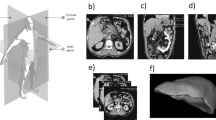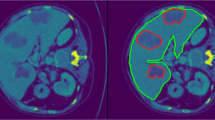Abstract
Image segmentation is one of the most popular methods in automated computational medical image analysis. Precise and significant semantic segmentation on abdominal Magnetic Resonance Imaging (MRI) and Computer Tomography (CT) volume images, specifically liver segmentation has a lot of contribution towards clinical decision making for patient treatment. Apart from the many state-of-the-art methods, different cutting-edge deep learning architectures are being developed rapidly. Those architectures are performing better segmentation while at the same time outperforming other state-of- the-art models. Different deep learning models perform differently based on cell types, organ shapes and the type of medical imaging (i.e. CT, MRI). Starting from 2D convolutional networks (CNN), many variations of 3D convolutional neural network architectures have achieved significant results in segmentation tasks on MRI and CT images. In this paper, we review performance of different 2D and 3D CNN models for liver image segmentation. We also analyzed studies that used variants of ResNet, FCN, U-Net, and 3D U-Net along with various evaluation metrics. How these variants of 2D and 3D CNN models enhance the performance against its state-of-the-art architectures are demonstrated in the results section. Besides the architectural development, each year, new segmentation and other biomedical challenges are being offered. These challenges come with their own datasets. Apart from challenges, some datasets are provided and supported by different organizations. Use of such data set can be found in this study. Moreover, this review of reported results, along with different datasets and architectures will help future researchers in liver semantic segmentation tasks. Furthermore, our listing of results will give the insight to analyze the use of different metrics for the same organs with the change in performances.
Access this chapter
Tax calculation will be finalised at checkout
Purchases are for personal use only
Similar content being viewed by others
References
Ronneberger, O., Fischer, P., Brox, T.: U-net: convolutional networks for biomedical image segmentation. In: Navab, N., Hornegger, J., Wells, W., Frangi, A. (eds.) Medical Image Computing and Computer-Assisted Intervention – MICCAI 2015. MICCAI 2015. Lecture Notes in Computer Science, vol. 9351. Springer, Cham (2015)
Reinke, A. et al.: How to exploit weaknesses in biomedical challenge design and organization. In: Frangi, A., Schnabel, J., Davatzikos, C., Alberola-López, C., Fichtinger, G. (eds.) Medical Image Computing and Computer Assisted Intervention – MICCAI 2018. MICCAI 2018. Lecture Notes in Computer Science, vol. 11073. Springer, Cham (2018)
He, K., Zhang, X., Ren, S., Sun, J.: Deep residual learning for image recognition. In: 2016 IEEE Conference on Computer Vision and Pattern Recognition (CVPR), Las Vegas, NV, pp. 770–778 (2016). https://doi.org/10.1109/cvpr.2016.90
Krizhevsky, A., Sutskever, I., Hinton, G.: ImageNet classification with deep convolutional neural net-works. In: NIPS (2012)
Simonyan, K., Zisserman, A.: Very deep convolutional networks for large-scale image recognition. arXiv:1409.1556 (2014)
Szegedy, C., Liu, W., Jia, Y., Sermanet, P., Reed, S., Anguelov, D., Erhan, D., Vanhoucke, V., Rabinovich, A.: The IEEE Conference on Computer Vision and Pattern Recognition (CVPR), pp. 1–9 (2015)
Çiçek, Ö., Abdulkadir, A., Lienkamp, S.S., Brox, T., Ronneberger, O.: 3D U-net: learning dense volumetric segmentation from sparse annotation. In: Ourselin, S., Joskowicz, L., Sabuncu, M., Unal, G., Wells, W. (eds.) Medical Image Computing and Computer-Assisted Intervention – MICCAI 2016. MICCAI 2016. Lecture Notes in Computer Science, vol. 9901. Springer, Cham (2016)
Jiang, H., Shi, T., Bai, Z., Huang, L.: AHCNet: an application of attention mechanism and hybrid connection for liver tumor segmentation in CT volumes. IEEE Access 7, 24898–24909 (2019). https://doi.org/10.1109/ACCESS.2019.2899608
Li, X., Chen, H., Qi, X., Dou, Q., Fu, C., Heng, P.: H-DenseUNet: hybrid densely connected UNet for liver and tumor segmentation from ct volumes. IEEE Trans. Med. Imaging 37(12), 2663–2674 (2018). https://doi.org/10.1109/TMI.2018.2845918
Hoang, H.S., Phuong Pham, C., Franklin, D., van Walsum, T., Ha Luu, M.: An evaluation of CNN-based liver segmentation methods using multi-types of CT abdominal images from multiple medical centers. In: 2019 19th International Symposium on Communications and Information Technologies (ISCIT), Ho Chi Minh City, Vietnam, pp. 20–25 (2019)
Xiao, Q., et al.: Hematoxylin and Eosin (H&E) stained liver portal area segmentation using multi-scale receptive field convolutional neural network. IEEE J. Emerg. Sel. Top. Circ. Syst. 9(4), 623–634 (2019). https://doi.org/10.1109/JETCAS.2019.2952063
Zhang, L., Xu, L.: An automatic liver segmentation algorithm for ct images u-net with separated paths of feature extraction. In: 2018 IEEE 3rd International Conference on Image, Vision and Computing (ICIVC), Chongqing, pp. 294–298 (2018). https://doi.org/10.1109/icivc.2018.8492721
Enokiya, Y., Iwamoto, Y., Chen, Y.-W., Han, X.-H.: Automatic liver segmentation using U-Net with Wasserstein GANs. J. Image Graph. 6(2), 152–159 (2018). https://doi.org/10.18178/joig.6.2.152-159
Nasiri, N., Foruzan, A.H., Chen, Y.: A controlled generative model for segmentation of liver tumors. In: 2019 27th Iranian Conference on Electrical Engineering (ICEE), Yazd, Iran, pp. 1742–1745 (2019). https://doi.org/10.1109/iraniancee.2019.8786681
Rezaei, M., Yang, H., Meinel, C.: Instance tumor segmentation using multitask convolutional neural network. In: 2018 International Joint Conference on Neural Networks (IJCNN), Rio de Janeiro, pp. 1–8 (2018). https://doi.org/10.1109/ijcnn.2018.8489105
Tang, Z., Chen, K., Pan, M., Wang, M., Song, Z.: An augmentation strategy for medical image processing based on statistical shape model and 3D thin plate spline for deep learning. IEEE Access 7, 133111–133121 (2019). https://doi.org/10.1109/ACCESS.2019.2941154
Liu, Z., Song, Y.-Q., Sheng, V.S., Wang, L., Jiang, R., Zhang, X., Yuan, D.: Liver CT sequence segmentation based with improved U-net and graph cut. Expert Syst. Appl. (2019). https://doi.org/10.1016/j.eswa.2019.01.055
LiTS Challenge. https://competitions.codalab.org/competitions/17094
D-IRCADb database. https://www.ircad.fr/research/3dircadb/
Acknowledgement
This work is supported by the North South University Office of Research funded projects 2019-2020. We thank the North South University for continuous support in research and publications.
Author information
Authors and Affiliations
Corresponding author
Editor information
Editors and Affiliations
Rights and permissions
Copyright information
© 2020 Springer Nature Singapore Pte Ltd.
About this paper
Cite this paper
Habib, A.B. et al. (2020). Performance Analysis of Different 2D and 3D CNN Model for Liver Semantic Segmentation: A Review. In: Su, R., Liu, H. (eds) Medical Imaging and Computer-Aided Diagnosis. MICAD 2020. Lecture Notes in Electrical Engineering, vol 633. Springer, Singapore. https://doi.org/10.1007/978-981-15-5199-4_17
Download citation
DOI: https://doi.org/10.1007/978-981-15-5199-4_17
Published:
Publisher Name: Springer, Singapore
Print ISBN: 978-981-15-5198-7
Online ISBN: 978-981-15-5199-4
eBook Packages: EngineeringEngineering (R0)




